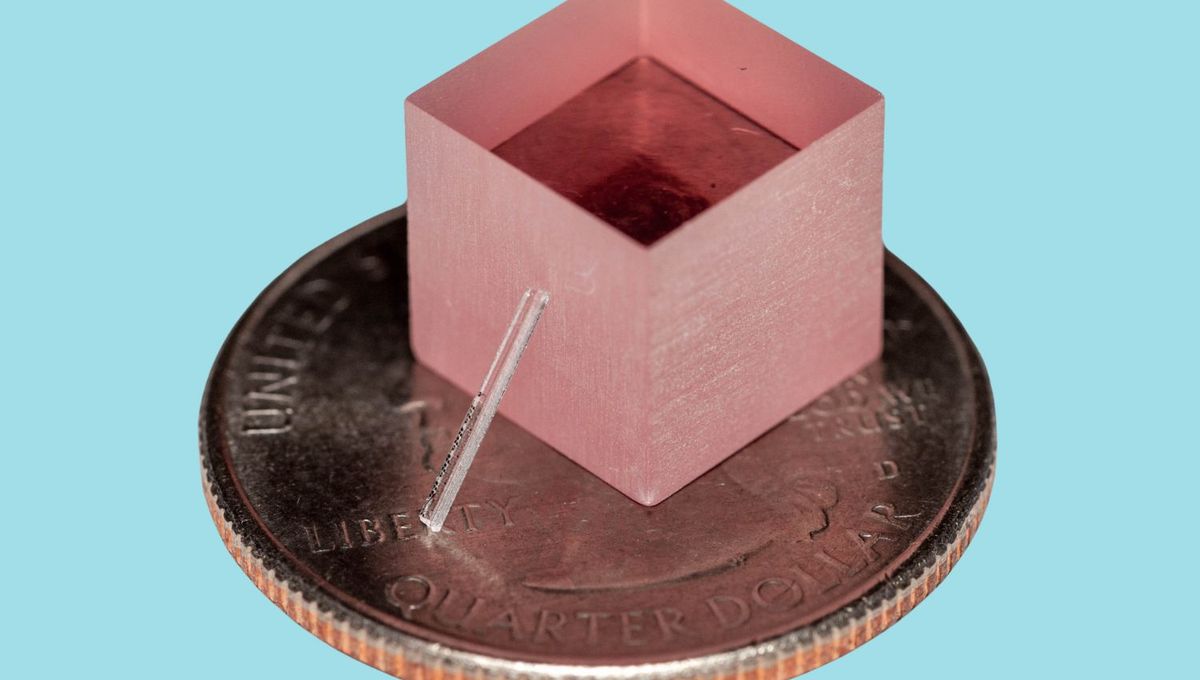
As pretty much every sci-fi movie ever has taught us, the future is going to be full of lasers. They will power our quantum computers; probe microscopic nooks and crannies in scientific experiments; we’ll use them in medicine, for surgeries, or to assess eye health – the possibilities are endless. There’s just one problem: so far, the best options we have – those made with titanium ion-doped sapphire crystals, known as titanium-sapphire or Ti:sapphire lasers – are far too large and expensive for general use.
So you can understand why the new development, by researchers at Stanford University, of a Ti:sapphire laser that can fit on a chip is so exciting. It’s four orders of magnitude smaller than any Ti:sapphire laser produced so far – measurable in millimeters rather than tens of meters – and three orders of magnitude less expensive. It’s even vastly more efficient than its predecessors.
“This is a complete departure from the old model,” said Jelena Vučković, the Jensen Huang Professor in Global Leadership, a professor of electrical engineering, and senior author of the recently published paper introducing the chip-scale Ti:sapphire laser, in a statement.
“Instead of one large and expensive laser, any lab might soon have hundreds of these valuable lasers on a single chip,” Vučković said. “And you can fuel it all with a green laser pointer.”
The breakthrough comes thanks to two innovations: firstly, rather than dealing with Ti:sapphire on its own, the team mounted it on an insulator made from silicon dioxide. The Ti:sapphire they did use – a layer just a few hundred nanometers thick – was then polished and etched with an intricate swirl of tiny ridges. The pattern, which looks rather like a coiled-up firehose, is known as a waveguide.
Light sent through this waveguide is then warmed using a tiny heater, basically allowing the team – or whoever ends up using this potentially soon-to-be-ubiquitous technology – to tune the laser to whatever wavelength they require.
The tiny laser could have profound benefits throughout science. Ti:sapphire lasers are indispensable in fields such as quantum optics, spectroscopy, and neuroscience, prized for their unrivaled gain bandwidth – a technical term meaning that energy can be emitted across a wider spectrum of wavelengths than in other lasers.
They’re also ultrafast, explained Joshua Yang, a doctoral candidate in Vučković’s lab and co-first author of the study, able to emit pulses of light every quadrillionth of a second – for reference, that’s about fourteen orders of magnitude faster than the kind of laser you can buy in a store.
But that performance comes at a cost – literally. A Ti:sapphire laser purchase could put you back hundreds of thousands of dollars just for the basic kit; you’ll need a spare bit of room to put it in, since it’ll take up about the same amount of space as, oh, say, four bowling balls; and of course, then there’s the multiple other high-powered lasers, each costing tens of thousands of dollars themselves, which you’ll need to power it.
It’s no surprise, then, that the tech is not currently what you’d call widespread. But a chip-sized version would change all that, said Yang: “When you leap from tabletop size and make something producible on a chip at such a low cost, it puts these powerful lasers in reach for a lot of different important applications,” he explained. “A chip is light. It is portable. It is inexpensive and it is efficient. There are no moving parts. And it can be mass-produced.”
And the bonus? Scaling it down like this doesn’t just make Ti:sapphire lasers smaller and cheaper – it actually makes them better.
“Mathematically speaking, intensity is power divided by area. So, if you maintain the same power as the large-scale laser, but reduce the area in which it is concentrated, the intensity goes through the roof,” explained Yang. “The small scale of our laser actually helps us make it more efficient.”
“What’s not to like? This democratizes Ti:sapphire lasers.”
The paper is published in the journal Nature.
Source Link: Lasers With “Unmatched” Performance Made Smaller, Cheaper, And More Intense